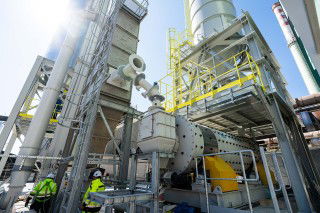In a week when it has been recorded that the cement sector is falling short of its commitments to reduce carbon emissions, the fear of the sector's over-reliance on the value of carbon capture as a decarbonisation solution may well be easing as alternative zero carbon solutions are starting to come to the fore.
A report by Oxford University on the 'State of Carbon Dioxide Removal' (CDR) across the globe has revealed that many industries are falling behind in their targets to tackle decarbonisation and limit average global warming to 1.5˚C this century. Urgent public policies, direct air capture deployment at the scale of carbon capture plants remain in the early development stages. Moreover, few countries have plans to scale CDR above current levels to close the gap. This is expected to expose a substantial shortfall. Limiting warming to below 2˚C will still involve hundreds of billions of tonnes of CO2 removal from the atmosphere, according to Oxford University.
In addition, the International Energy Agency (IEA) tracked over 50 clean energy components in 2023 and only three were evaluated as being on track to meet CO2 removal targets – electric vehicles, lighting and solar power. The IEA's analysis sees the cement sector as one of the heavy industries falling short of its CO2 removal goals. While CO2 emissions from the sector have been remained broadly flat over the last five years, "annual CO2 intensity declines of four per cent through to 2030 are required for the sector to get on track with the Net Zero Emissions by 2050 (NZE) Scenario," claims the IEA.
CCS knock-backs and groundbreaking
As attention is being directed at the cement sector's need to close the gap with its CDR programme, Calix confirmed this week that it will transfer its Leilac-2 CCS project from Heidelberg Materials’ Hanover plant to the Ennigerloh facility in Germany. Heidelberg Materials' decision to stop clinker production at Hanover is now expected to see a delay in Leilac-2 implementation. It will be a minimal delay and at minimal capital cost to the project, claims Heidelberg Materials. However, additional engineering work and site-specific permitting and integration can be expected.
Better news comes from elsewhere in Germany where plans are advancing for carbon capture utilisation and storage (CCUS). Rohrdorfer Zement broke ground on its CO2 capture plant in February, but it will take until late autumn 2026 before this facility is producing 50,000tpa of CO2-free cement.
Meanwhile, Heidelebrg Material's Padeswood carbon capture facility in the UK is taking shape. The announcement in February that Mitsubishi Heavy Industries Group has been awarded the front-end engineering and design (FEED) contract for the project added momentum to this UK Track 1 capture project (HyNet industrial cluster).
Before the UK plant is completed, Heidelberg Materials is expected to see the commercial launch of its Brevik carbon capture plant in Norway later this year. But only a handful of cement plants will likely have reached this stage in Europe by 2030. Full carbon capture might be out of reach for many cement producers before 2030, but efforts to find other ways to reduce CO2 in the cement production process are growing.
Low-carbon plants planned
Only this week, EMC Cement and HES International announced their plan to develop a 1.2Mta zero-carbon cement plant in The Netherlands. The idea is to use volcanic ash as a 70 per cent substitute for Portland limestone in cement manufacture by 4Q25-1Q26. Located in Amsterdam, the project will have the ideal location to sell its low-carbon cement in Belgium, UK, Germany, France and Scandinavia.
CEMEX also recently announced the start of its micronisation process that will use proprietary admixtures to lower the clinker factor by 50 per cent and thereby reduce CO2.
Reaching Net Zero
While such progress indicates that the cement sector is taking on the challenge of reducing its CO2 emissions, it also underlines carbon capture is not going to solve the industry's problems on its own. Investment must be broad-based across a range of carbon removal technologies for the industry to have the best chance in achieving its goals.
Continued innovation is key as is using a range of decarbonisation solutions if the cement industry wants to achieve its Net Zero goal. Meeting the challenge still requires much more planning and investment in infrastructure and technologies as well as state funding. Carbon-free cement is the ultimate goal, but each ton of carbon that can be cut now is critical, and will have a significant impact on reducing the worst effects of global warming.
